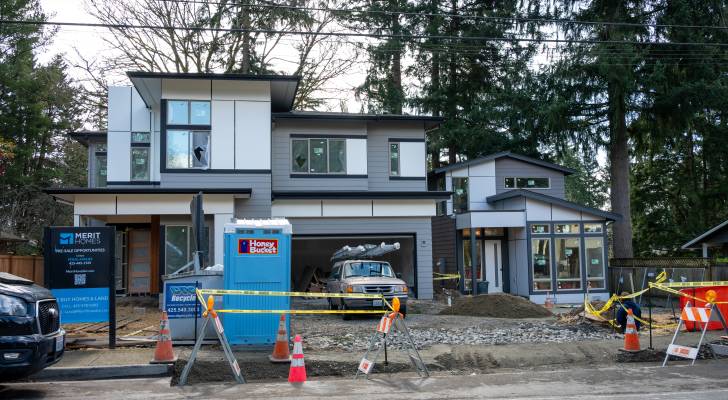
Unattainable home ownership due to increasingly exorbitant home prices is something that many North Americans are affected by, no matter how diligent they are with their finances.
Take Aislyn and Ali Benjamin, who were priced out of their dream neighbourhood in California, and instead of chasing listings and feeling a sense of discontent, the Benjamins built a US$500,000 (CDN$700,000) Accessory Dwelling Unit (ADU) in the backyard of Ali’s parents’ property.
“This was the best decision we ever made,” Ali, 35, said to Business Insider (1). “It allowed us to save so much money and live where we wanted.”
Home prices in Canada aren’t fairing any better, particularly in metropolitan areas. In Toronto — where the average home sale price was about $1.059 million in September 2025, according to the Toronto Regional Real Estate Board (2) — even small detached homes have become out of reach for most families.
Don’t Miss
- Want to retire with an extra $1.3M? See how Dave Ramsey’s viral 7-step plan helps millions kill debt and build wealth — and how you can too
- The Canadian economy shrank in Q2 2025 — protect your wallet with these 6 essential money moves (most of which you can complete in just minutes)
- Boomers are out of luck: Robert Kiyosaki warns that the ‘biggest crash in history is coming’ — here’s his strategy to get rich before things get worse
Cutting costs, not corners
Before moving, the Benjamins paid US$3,065 (CDN$4,300) a month for a two-bedroom apartment. Their new 1,200-square-foot ADU — complete with three bedrooms, a private sauna and a small gym — now costs about US$2,880 (CDN$4,000) a month, including utilities on a 15-year mortgage. That’s a modest saving of around US$185 (CDN$300) a month, but their payments now go toward equity, not rent.
They also benefit from lower power bills, thanks to their parents’ rooftop solar panels, and they split utilities. With no condo or HOA fees — something that can easily add hundreds per month in newer Toronto buildings — their overall expenses are significantly lower.
Then there are the hidden savings: Ali’s parents can offer help with their dog negating the need for boarding fees, as well as future childcare savings once they have children. Here in Canada, even with the federal 10-a-day childcare plan (3), Toronto daycare costs can still range from $400 to $500 per month as of 2021 (4).
The perks of proximity
Beyond the finances, the Benjamins say multigenerational living has its upsides. They enjoy being close enough to share errands — but far enough to maintain privacy.
Their ADU has a separate entrance and mailbox, and sits at a comfortable distance from the main house. “My parents are very private and respectful,” Ali said. “They don’t come over unannounced.”
The couple’s long-term plan is to swap homes once they have kids — they’ll move into the main house, while Ali’s parents downsize into the garden suite.
Read more: What is the best credit card in Canada? It might be the RBC® British Airways Visa Infinite, with a $1,176 first-year value. Compare it with over 140 more in 5 seconds
The trade-offs
Still, there are drawbacks. Because Ali’s parents own the property, big decisions like adding a pool or expanding the suite need their approval.
There’s also the social stigma.
"I think the biggest misconception we got when I told people we were getting an ADU is that they imagined it as a tiny shack in someone’s backyard," Ali recalled. "In reality, there are homes that are much smaller than our ADU."
Even with its size and privacy, not everyone would feel comfortable living on family land — especially if the boundaries or expectations are unclear.
Could you save money another way to purchase a home?
For many first-time Canadian buyers, government and bank programs offer help — but not nearly enough in high-cost cities. The First Home Savings Account (FHSA) lets buyers save up to $40,000 tax-free, while the Home Buyers’ Plan (5) allows withdrawals of up to $60,000 from RRSPs for a down payment.
There’s also the First-Time Home Buyer Incentive (6), which contributes up to 10% of a home’s price through a shared-equity mortgage.
Major financial institutitions like Scotiabank offer programs to fastrack home ownership — StartRight (7) is available for first-time buyers that are permanent residents who need to purchase their first home.
Still, in markets like Toronto or Vancouver, where detached homes often exceed $1 million, these programs can’t compete with the cost of traditional ownership.
For the Benjamins, building a backyard suite was the more practical path. It allowed them to stay close to work, keep their family nearby and start building equity without taking on a million-dollar mortgage.
As Aislyn put it, “Being able to save money and put it toward something that we love is a huge benefit.”
What To Read Next
- Here are 5 expenses that Canadians (almost) always overpay for — and very quickly regret. How many are hurting you?
- Ray Dalio just raised a red flag for Americans who ‘care’ about their money — here’s why Canadians should limit their exposure to U.S. investments
- I’m almost 50 and don’t have enough retirement savings. What should I do? Don’t panic. Here are 6 solid ways you can catch up
- Here are the top 7 habits of ‘quietly wealthy’ Canadians. How many do you follow?
Article sources
We rely only on vetted sources and credible third-party reporting. For details, see our editorial ethics and guidelines.
Business Insider (1); Toronto Regional Real Estate Board (2); Government of Canada (3, 5); Cozy Time (4); CMHC (6); Scotiabank (7)
This article provides information only and should not be construed as advice. It is provided without warranty of any kind.